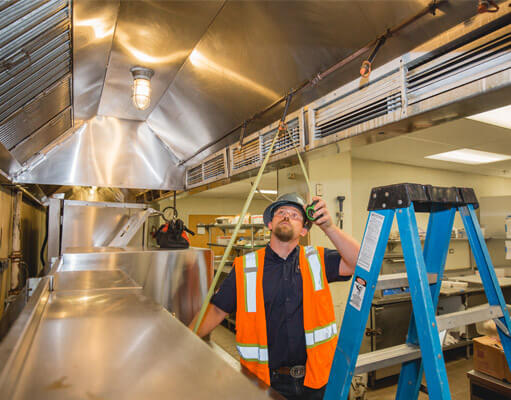
Over time, kitchen exhaust hoods, ducts, and fans collect grease that restrict air flow, reducing overall efficiency, and creating an extreme fire hazard.
Our background in fire protection and our elite processes combined with our quality standards separates us from your typical ventilation cleaning company. Our technicians are trained to work with and around the fire system components, allowing them unobstructed access to clean your entire system. We clean your kitchen exhaust down to bare metal per NFPA-96. We use state of the art hot water, high pressure washers with an FDA approved cleaning agent to remove grease and other fire hazards from your kitchen exhaust system.
The new fire code does not reference cleaning frequency, it references inspection frequency and subsequent cleaning. Should your exhaust system have greater than .002 inches of grease in your duct, plenum, or fan, the requirement for a cleaning comes into effect. Our goal is to eliminate your fire hazards, improve the efficiency of your ventilation system, and leave your kitchen looking brand new.
You will not only avoid fires, but also fines from the fire department, city health inspector, and insurance claims resulting from under-cleaned cooking areas. Don’t be fooled, restaurant fires are extremely serious, let alone imminent, if your exhaust system has not been cleaned properly.
We work in all kinds of environments, from healthcare facilities and hotels, to college campuses, restaurant chains, inns and diners. If you have a kitchen exhaust system, Impact Fire is the company you can trust to clean it.
CLEANING PROCESS
A Kitchen Exhaust Cleaning will include:
- Inspection of fans for proper operation and code compliance
- Covering and removal of the appliance and draping of the hood
- Removal, soaking and cleaning of filters; check that filters are properly maintained
- Disarming of the fire suppression system
- Scraping and cleaning of the hood duct and plenum area
- Cleaning of the system with a high-pressure washer and FDA approved cleaning chemical
- Removal and reinstallation of the cleanout ports and resealing
- Verification of the integrity of the ventilation system and check for leaks
- Cleaning the fan and replacement of the belt if provided
- Maintenance and documentation of the grease containment system (optional)
- Inspection and documentation of the roof condition
- Cleaning of the affected area around the equipment line and polishing of the hood
- Rearming of the fire suppression system
- Inspection of the fire suppression system and portable fire extinguishers (optional)
- Placement of stickers and documentation on the hood
- Re-lighting of the pilots
- Verification of fan operation
- Returning the kitchen to proper order





